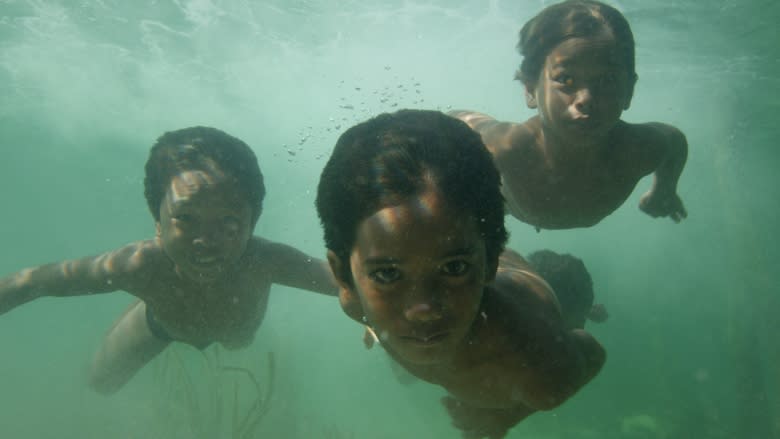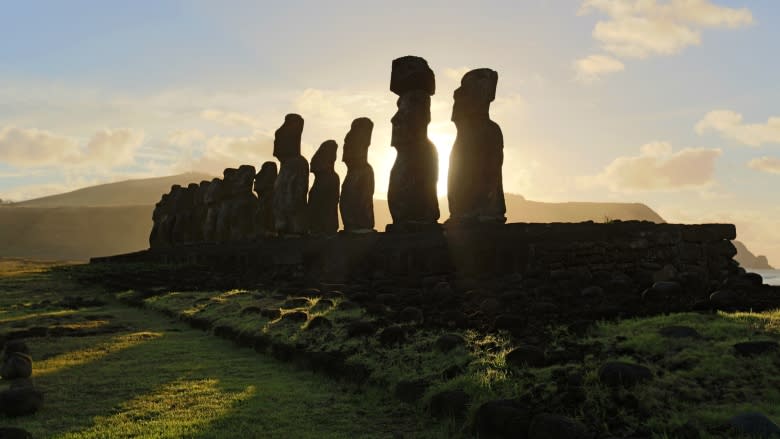How climate change made humans who we are
Humans are unlike any other species on Earth. But it wasn't always that way, says Canadian anthropologist and filmmaker Niobe Thompson.
Planet Earth, he says, was once like the fictional Middle Earth of J.R.R. Tolkein's Lord of the Rings.
"At the beginning, there were a lot of other kinds of humans … other intelligent walking apes just like us. Over that space of time they all went extinct and only one survived.
"It's a wonderful starting point for a story. What is it that makes us the great survivor?"
It's a story that Thompson tells in a new three-part documentary series calledThe Great Human Odyssey, which debuts tonight on CBC-TV's The Nature of Things.
In it, Thompson visits anthropologists at archaeological sites and laboratories around the world, and explores the latest research about human origins. He also visits traditional cultures who still live the way our ancestors once lived in an effort to uncover how they survived when all our hominin cousins went extinct.
One of the big surprises for him was that in the past million years, humans evolved not in a lush, Eden-like Africa but one with a wildly unstable climate, swinging quickly between floods and droughts, heat and cold within the span of a human lifetime.
Thompson thinks that fluctuation played a big role in the natural selection that made humans what they are today.
"What I'm convinced by is climate shifts were a really important forcer. They forced our evolution rapidly and in certain directions," he said in an interview.
DNA evidence shows that during that period of time, humans came close to going extinct — our population may have dropped as low as 600 individuals.
'Incredibly expensive brain'
At the same time, we evolved what Thompson calls our "incredibly expensive brain" — one that uses 20 per cent of our oxygen even though it makes up only two per cent of our mass.
The documentary suggests that this brain, which gives us the ability to learn and adjust our behaviour in ways that other animals can't, may have been key to our survival.
We can't know for sure that climate shifts are what made Neanderthals and other African hominins go extinct, Thompson concedes, "but it is pretty suggestive when you look at the climate record."
To see how ancient humans survived conditions that likely wiped out their hominin cousins, Thompson and his crew spent time among traditional cultures including:
- The Kalahari bushmen, who still live a hunter gatherer lifestyle in an African desert with almost no water.
- The Crocodile People of Papua New Guinea, whose rare, secret skin-cutting initiation ritual was captured on film for the series.
- The Badjao of the Philippines, the last remaining free-diving nomads in the world, who can spend several minutes at a time holding their breath up to 40 metres underwater as they gather food from the sea floor.
In the process, Thompson sampled and tasted many unusual delicacies, from sausage-sized beetle larvae in Papua New Guinea to mangeti nuts pulled undigested out of elephant dung in the Kalahari Desert. Returning to the Kalahari bushmen's village, he also tried what he called a delicious paste of mushed-up grass and asked the women of the village about the recipe.
"They said, 'Well, you get a bunch of the grass and you put it into the mortar and pestle — and then you spit into it,'" he recalled with a grimace and a laugh.
The crew filmed in some places that were extremely dangerous. The Badjao had never been filmed before because they are surrounded by a violent civil war. Thompson and his crew arranged for the Philippine military to protect them.
"At the end of our shoot, the captain of the Navy Seals brigade who was protecting us said, 'We think you're the first foreigners who have come to this region since 2000 who haven't been kidnapped.'".
New discovery on Easter Island
Over the course of the filming, Thompson had the opportunity to witness some fascinating scientific discoveries in the making.
In one case, scientists revealed through DNA studies that the Rapa Nui people on remote Easter Island in the South Pacific interbred with native South Americans long before Europeans reached the continent. That suggested that they had made the sea journey of more than 3,500 kilometres to South America, and then returned.
The Human Odyssey showcases humans' remarkable adaptability, which has allowed them to spread throughout the world into even harsh and extreme environments. But while it suggests that climate change helped bring about the inventiveness that made that possible, Thomson isn't confident that it means we're well positioned to weather the climate change that we are bringing about today.
"I think we are in trouble… I think one of our greatest tricks in the deep past was moving on," he said. "We don't really have that trick anymore because the planet is full."
But having seen the tricks that humans all over the world have come up with to survive and thrive, Thompson does have some optimism in ability of humans to tackle this new problem.
"What we do have that I think is probably unprecedented," he said, "is the ability to consider the future and modify our behaviour in the present."
The Great Human Odyssey debuts on Thursday, Feb. 12 at 8 p.m. on CBC-TV's The Nature of Things
Correction : An earlier version of this story said that the Badjao dive as deep as 100 metres. In fact, 100 metres is the limit of the best human free-divers. The Badjao typically dive to depths of 20 to 40 metres.(Feb 13, 2015 9:49 AM)





